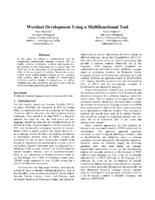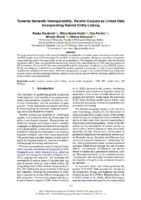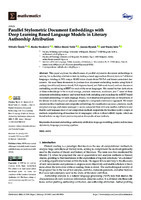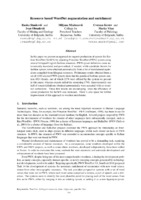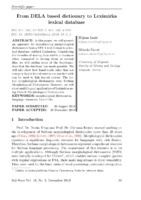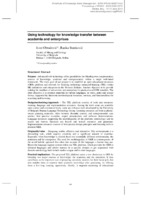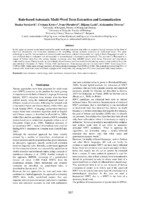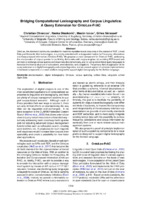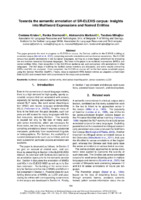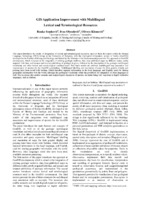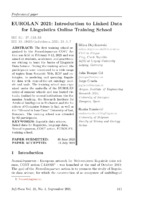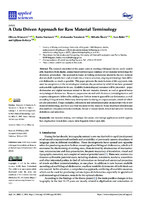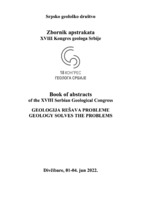Претрага
180 items
-
Wordnet Development Using a Multifunctional Tool
Ivan Obradović, Ranka Stanković (2007)In this paper we present a multifunctional tool for manipulating heterogeneous language resources. The tool handles electronic dictionaries, wordnets and aligned texts, and provides for their synchronous use in various tasks. We focus here on the description of the possibilities this tool offers in the development of wordnets. Besides the wordnet module which enables parallel handling of two wordnets, other modules, such as the module for morphological dictionaries and the module for aligned texts, as well as available finite ...... such as Serbian, where two alphabets, Cyrillic and Latin are equally used. WS4LR enables the exploitation of language resources both in Cyrillic and Latin alphabet, as well as in a special encoding, that uses the ASCII character set and that can be unambiguously transformed into Serbian Latin ...
... tool that integrates diverse language resources and is thus more powerful than the majority of other wordnet tools. The desktop version of WS4LR is fully operational and is already being used as the main tool for developing resources in Serbian, including the Serbian wordnet, but its commercial ...
... provides a common semantic framework for all the languages, while language specific properties are maintained in the individual wordnets. BalkaNet, a project aimed at developing wordnets for Bulgarian, Greek, Romanian, Serbian and Turkish and expanding the Czech wordnet, followed an approach ...Ivan Obradović, Ranka Stanković. "Wordnet Development Using a Multifunctional Tool" in Proceedings of the International Workshop Computer Aided Language Processing (CALP) '2007, Borovets, Bulgaria, September 2007, - (2007)
-
A Tel Platform Blending Academic And Entrepreneurial Knowledge
... be mentioned that due to the complex Serbian grammar the language support system also features grammars implemented through finite state automata, finite state transducers and compound inflection rules. The language resources in the BAEKTEL language support system are managed by a web ...
... The BAEKTEL language support system consists of several software components handling simultaneously several types of language resources: grammars, lexical and textual resources (Fig 2). One of the basic lexical resources is the system of morphological dictionaries of Serbian simple words and ...
... the query morphologically, which is especially important for Serbian, due to its morphological richness. The query can also be expanded to another language thus supporting multilinguality within BAEKTEL. The BAEKTEL language support system is a very important part of the entire concept ...Ivan Obradović, Ranka Stanković, Jelena Prodanović, Olivera Kitanović. "A Tel Platform Blending Academic And Entrepreneurial Knowledge" in Proceedings of the The Fourth International Conference on e-Learning (eLearning-2013), September 2013, Belgrade, Serbia, Belgrade, Serbia : Belgrade Metropolitan University (2013)
-
Towards Semantic Interoperability: Parallel Corpora as Linked Data Incorporating Named Entity Linking
U radu se prikazuju rezultati istraživanja vezanih za pripremu paralelnih korpusa, fokusirajući se na transformaciju u RDF grafove koristeći NLP Interchange Format (NIF) za lingvističku anotaciju. Pružamo pregled paralelnog korpusa koji je korišćen u ovom studijskom slučaju, kao i proces označavanja delova govora, lematizacije i prepoznavanja imenovanih entiteta (NER). Zatim opisujemo povezivanje imenovanih entiteta (NEL), konverziju podataka u RDF, i uključivanje NIF anotacija. Proizvedene NIF datoteke su evaluirane kroz istraživanje triplestore-a korišćenjem SPARQL upita. Na kraju, razmatra se povezivanje Linked ...paralelni korpusi, povezivanje imenovanih entiteta, prepoznavanje imenovanih entiteta, NER, NEL, povezani podaci, NIF, VikipodaciRanka Stanković, Milica Ikonić Nešić, Olja Perisic, Mihailo Škorić, Olivera Kitanović. "Towards Semantic Interoperability: Parallel Corpora as Linked Data Incorporating Named Entity Linking" in Proceedings of the 9th Workshop on Linked Data in Linguistics @ LREC-COLING 2024, Turin, 20-25 May 2024, ELRA and ICCL (2024)
-
Parallel Stylometric Document Embeddings with Deep Learning Based Language Models in Literary Authorship Attribution
This paper explores the effectiveness of parallel stylometric document embeddings in solving the authorship attribution task by testing a novel approach on literary texts in 7 different languages, totaling in 7051 unique 10,000-token chunks from 700 PoS and lemma annotated documents. We used these documents to produce four document embedding models using Stylo R package (word-based, lemma-based, PoS-trigrams-based, and PoS-mask-based) and one document embedding model using mBERT for each of the seven languages. We created further derivations of these ...Mihailo Škorić, Ranka Stanković, Milica Ikonić Nešić, Joanna Byszuk, Maciej Eder. "Parallel Stylometric Document Embeddings with Deep Learning Based Language Models in Literary Authorship Attribution" in Mathematics, MDPI AG (2022). https://doi.org/10.3390/math10050838
-
Resource-based WordNet Augmentation and Enrichment
In this paper we present an approach to support production of synsets for SerbianWordNet(SerWN)byadjustingPrincetonWordNet(PWN)synsetsusing several bilingual English-Serbian resources. PWN synset definitions were automatically translated and post-edited, if needed, while candidate literals for Serbian synsets were obtained automatically from a list of translational equivalents compiled form bilingual resources. Preliminary results obtained from a setof1248selectedPWNsynsetsshowthattheproducedSerbiansynsetscontain 4024 literals, out of which 2278 were offered by the system we present in this paper, whereas experts added the remaining 1746. Approximately one half of ...... API. We used the LanguageApp service in Google Apps Script2 to create our own version of Language Translation API, which, unlike the official Google Language Translation API, produces text translated into Serbian in Latin script, instead of Cyrillic, and serializes it into a plain text file.3 An example ...
... approach to word sense alignment. TACL, 1:151–164. Mladenović, M. and Mitrović, J. (2014). Natural Language Processing for Serbian – Resources and Application, chapter Semantic Networks for Serbian: New Functionalities of Developing and Maintaining a WordNet Tool. University of Belgrade, Mathematical Faculty ...
... chancery which is converted, after translation by our Translation API based on Google Language Translation API, into: ENG30-08331011-n | sud koji je nadležan za pravičnost | kancelarija ; sudski ured If a Serbian translational equivalent for a PWN literal obtained by Google Translation is not of- ...Ranka Stanković, Miljana Mladenović, Ivan Obradović, Marko Vitas, Cvetana Krstev. "Resource-based WordNet Augmentation and Enrichment" in Proceedings of the Third International Conference Computational Linguistics in Bulgaria (CLIB 2018), May 27-29, 2018, Sofia, Bulgaria, Sofia : The Institute for Bulgarian Language Prof. Lyubomir Andreychin, Bulgarian Academy of Sciences (2018)
-
From DELA Based Dictionary to Leximirka Lexical Database
Biljana Lazić, Mihailo Škorić (2020)In this paper, we will present an approach in transforming Serbian language Morphological dictionaries from a DELA text format to a lexical database dubbed Leximirka. Considering the benefits of storing data within a database when compared to storing them in textual documents, we will outline some of the functionality that the database has made possible. We will also show how hand-made rules that use category labels lexical entries are marked with can be used to link lexical entries. ...... frequent words in the Serbian Corpus of the Serbian Language SrbCorp (version of 122 million words by Duško Vitas and Miloš Utvić)6. Information about the Corpus is stored in the KorpusMeta table. The LexicalRelation table stores information 6 Corpus of the Serbian Language – SrbCorp 86 Infotheca ...
... MultilingualLabels table was created with the idea of pre- senting meta-language that is used for description of labels, eg. labels and its description could be described in Serbian, English, French, etc. Currently only Serbian language is in use. 4 Leximirka application 4.1 Interface Leximirka application ...
... represent a significant resource for Serbian language processing. The importance of this resource is in its multiple applications. Although Serbian morphological dictionaries (SMD) were initially developed for Unitex1, which enables various complex queries with regular expressions or FSA, their main importance ...Biljana Lazić, Mihailo Škorić. "From DELA Based Dictionary to Leximirka Lexical Database" in Infotheca, Faculty of Philology, University of Belgrade (2020). https://doi.org/10.18485/infotheca.2019.19.2.4
-
Digital Library From A Domain Of Criminalistics As A Foundation For A Forensic Text Analysis
U ovom radu predstavljen je model koji omogućava prikupljanje, pripremu, opis metapodataka, upravljanje i eksploataciju, uključujući pretragu punog teksta dokumenata iz domena kriminalistike napisanih na srpskom jeziku. Predloženi pristup primenjuje se na veb portalu koji sakuplja različite tekstove nastale iz časopisa Akademije za kriminalistiku i policijske studije, Krivičnog zakona Srbije, konferencija „Tara“ i „Reiss“, kao i iz nekih doktorskih disertacija vezanih za ovu oblast istraživanje. Nakon obrade teksta, korpus koji sadrži preko 5500 stranica običnog teksta, kreiran je i ...... depicted in Figure 3 on the left, while on the right are main application components of the language support system. Main lexical resources include morphological dictionaries for Serbian language15, Serbian and English WordNets, terminological databases: Termi, GeolISSTerm, RudOnto and Librarian ...
... I. Obradović & D. Vitas Natural Language Processing for Serbian – Resources and Application, 1-11. Matematički fakultet, Beograd. 21 Mladenović, M., Mitrović, J., Krstev, C., & Vitas, D. (2015). Hybrid Sentiment Analysis Framework For A Morphologically Rich Language. Journal of Intelligent Information ...
... Interantional Conference on Language Resources and Evaluation (LREC'08), Marrakech, Morocco, 28-30 May 2008, European Language Resources Association (ELRA), 2008 4. Duško Vitas, Cvetana Krstev, Ivan Obradović, Ljubomir Popović, Gordana Pavlović-Lažetić”,An Processing Serbian Written Texts: An Overview ...Dalibor Vorkapić, Aleksandra Tomašević, Miljana Mladenović, Ranka Stanković, Nikola Vulović. "Digital Library From A Domain Of Criminalistics As A Foundation For A Forensic Text Analysis" in International Scientific Conference “Archibald Reiss Days” Thematic Conference Proceedings Of International Significance, Belgrade, 7-9 November 2017, Academy Of Criminalistic And Police Studies Belgrade (2017)
-
An Approach to Development of Bilingual Lexical Resources
... one term can belong to one or more synsets, and that one synset can have several terms from the corresponding language. In its initial phase, Biblimir is conceived as a bilingual Serbian-English resource, but the model enables further expansion to other languages, such as French, German, etc. ...
... appeared in one language without its translational equivalent in the other. In such cases an appropriate entry to Biblimir was considered. In this section we will illustrate this process with several examples. Table 1: Overview of Available Resources E-dictionaries Serbian Wordnet Dictionary ...
... Multilingual textual repositories, such as digital libraries of e- journals represent a specific type of language resources. Efficient search of these resources usually relies on specific language tools, which often use other available resources, such as e-dictionaries, wordnets and the like. An ...Stanković Ranka, Obradović Ivan, Trtovac Aleksandra. "An Approach to Development of Bilingual Lexical Resources" in Proceedings of the Fifth Balkan Conference in Informatics BCI 2012, Workshop on Computational Linguistics and Natural Language Processing of Balkan Languages – CLoBL 2012, September 2012, Novi Sad : BCI (2012)
-
Keyword-Based Search on Bilingual Digital Libraries
This paper outlines the main features of Biblisha, a tool that offers various possibilities of enhancing queries submitted to large collections of aligned parallel text residing in bilingual digital library. Biblishsa supports keyword queries as an intuitive way of specifying information needs. The keyword queries initiated, in Serbian or English, can be expanded, both semantically, morphologically and in other language, using different supporting monolingual and bilingual resources. Terminological and lexical resources are of various types, such as wordnets, electronic ...Ranka Stanković, Cvetana Krstev, Duško Vitas, Nikola Vulović, Olivera Kitanović. "Keyword-Based Search on Bilingual Digital Libraries" in Semantic Keyword-Based Search on Structured Data Sources - Second COST Action IC1302 International KEYSTONE Conference, IKC 2016, Springer (2017). https://doi.org/10.1007/978-3-319-53640-8_10
-
Using Query Expansion for Cross-Lingual Mathematical Terminology Extraction
Velislava Stoykova, Ranka Stanković (2018)Velislava Stoykova, Ranka Stanković. "Using Query Expansion for Cross-Lingual Mathematical Terminology Extraction" in Advances in Intelligent Systems and Computing, Springer International Publishing (2018). https://doi.org/10.1007/978-3-319-91189-2_16
-
Using technology for knowledge transfer between academia and enterprises
Ivan Obradović, Ranka Stanković (2014)... is especially important for morphologically rich languages such as Serbian. In order to support the multilinguality of the TEL platform, LSS can also expand the query in one language to another language, e.g. a query in Serbian to English or Russian, and vice-versa. With all the aforementioned ...
... use of. Specific features of Serbian grammar need corresponding language resources in the form of grammars. Grammars within LSS are implemented by the so called finite state automata, finite state transducers and compound inflection rules (Krstev, 2008). The language support system handles various ...
... TEL platform consists of tools and resources: learning, language and implementation resources. Among the tools some are available open source and commercial tools, some are in-house tools developed by the University of Belgrade Human Language Technology Group. Learning resources are both academic: ...Ivan Obradović, Ranka Stanković. "Using technology for knowledge transfer between academia and enterprises" in Knowledge and Management Models for Sustainable Growth, Proc. of IFKAD 2014, 9th International Forum on Knowledge Asset Dynamics, 11-13 June 2013, Matera, Italy, Bari : IFKAD (2014)
-
Rule-based Automatic Multi-word Term Extraction and Lemmatization
In this paper we present a rule-based method for multi-word term extraction that relies on extensive lexical resources in the form of electronic dictionaries and finite-state transducers for modelling various syntactic structures of multi-word terms. The same technology is used for lemmatization of extracted multi-word terms, which is unavoidable for highly inflected languages in order to pass extracted data to evaluators and subsequently to terminological e-dictionaries and databases. The approach is illustrated on a corpus of Serbian texts from ...... Krstev, C., Obradović, I., Pavlović-Lažetić, G. and Stanojević, M. (2012). The Serbian Language in the Digital Age. Berlin; Springer-Verlag. 8. Language Resource References Vitas D., Utvić M. (2015). SrpKor22M, Serbian automatically lemmatized, PoS and morphosyntactically annotated corpus 22M ...
... of MWT extraction and lemmatization from Serbian texts we have chosen a rule-based approach, which relies on a system of language resources such as morphological e-dictionaries and grammars developed within the University of Belgrade Human Language Technology Group (Vitas et al., 2012). For ...
... compare term frequency in the domain corpus and the general language corpus, thus illustrating how specific the MWU is for the selected domain. As the general corpus we used a 22 million words excerpt from the Corpus of Contemporary Serbian (SrpKor – http://www.korpus.matf.bg.ac.rs). The computed ...Ranka Stanković, Cvetana Krstev, Ivan Obradović, Biljana Lazić, Aleksandra Trtovac. "Rule-based Automatic Multi-word Term Extraction and Lemmatization" in Proceedings of the 10th International Conference on Language Resources and Evaluation, LREC 2016, Portorož, Slovenia, 23--28 May 2016, European Language Resources Association (2016)
-
Bridging Computational Lexicography and Corpus Linguistics: A Query Extension for OntoLex-FrAC
OntoLex, dominantni standard zajednice za mašinski čitljive leksičke resurse u kontekstu RDF-a, Linked Data i tehnologija Semantičkog veba, trenutno se proširuje sa posebnim modulom za Frekvencije, Primere i Informacije zasnovane na Korpusu (OntoLex-FrAC). Predlažemo novi komponent za OntoLex-FrAC, koji se bavi inkorporacijom korpusnih upita za (a) povezivanje rečnika sa korpusnim mašinama, (b) omogućavanje RDF baziranih web servisa da dinamički razmenjuju korpusne upite i podatke odgovora, i (c) korišćenje konvencionalnih upitačkih jezika za formalizaciju unutrašnje strukture kolokacija, skica reči i ...standardizacija, digitalna leksikografija, OntoLex, upiti korpusa, povezani podaci, Lingvistički povezani otvoreni podaciChristian Chiarcos, Ranka Stanković, Maxim Ionov, Gilles Sérasset. "Bridging Computational Lexicography and Corpus Linguistics: A Query Extension for OntoLex-FrAC" in Proceedings of the 2024 Joint International Conference on Computational Linguistics, Language Resources and Evaluation (LREC-COLING 2024), Turin, 20-25 May 2024, LREC (2024)
-
Towards the semantic annotation of SR-ELEXIS corpus: Insights into Multiword Expressions and Named Entities
Овај рад представља активности на развоју корпуса ELEXIS-sr, српском додатку вишејезичном анотираном корпусу ELEXIS-а, који се састоји од семантичких анотација и репозиторија значења речи. ELEXIS је паралелни вишејезични анотирани корпус на десет европских језика, који може да се користи као вишејезички репер за евалуацију европских језика са мање и средње развијеним ресурсима. Фокус овог рада је на вишечланим изразима и именованим ентитетима, њиховом препознавању у скупу реченица ELEXIS-sr и поређењу са анотацијама на другим језицима. Разматрају се први кораци ...Cvetana Krstev, Ranka Stanković, Aleksandra Marković, Teodora Mihajlov. "Towards the semantic annotation of SR-ELEXIS corpus: Insights into Multiword Expressions and Named Entities" in Proceedings of the Joint Workshop on Multiword Expressions and Universal Dependencies (MWE-UD) @ LREC-COLING 2024, Turin, May 25, 2024, ELRA and ICCL (2024)
-
GIS Application Improvement with Multilingual Lexical and Terminological Resources
... geodatabase. Multilingual labelling and annotation of maps for their graphic display and printing have been tested with Serbian, which describes regional information in the local language, and English, used for sharing geographic information with the world, although the geological vocabulary offers the ...
... expansion. Multilingual labelling and annotation of maps for their graphic display and printing have been tested with Serbian, which describes regional information in the local language, and English, used for sharing geographic information with the world. However, other languages could also have been ...
... data practically language independent, thus substantially broadening the group of potential users. Figure 3: An example of automatic map annotation in English and Serbian 5. GeolISS Query ...Ranka Stanković, Ivan Obradović, Olivera Kitanović. "GIS Application Improvement with Multilingual Lexical and Terminological Resources" in Proceedings of the 5th International Conference on Language Resources and Evaluation, LREC 2010, Valetta, Malta, May 2010, Valetta, Malta : European Language Resources Association (2010)
-
EUROLAN 2021: Introduction to Linked Data for Linguistics Online Training School
Prva škola za obuku polaznika koju je organizovala COST akcija NexusLinguarum održana je od 8. do 12. februara 2021. godine sa ciljem da studenti, istraživači i stručnjaci nauče osnove lingvističke nauke o podacima. Tokom obuke polaznici su se upoznali sa širokim spektrom tema: od semantičkog veba, RDF -a i ontologija, do modeliranja i pretraživanja jezičkih podataka pomoću najsavremenijih ontoloških modela i alata. Škola je održana u okviru serije letnjih škola EUROLAN-a i organizovalo ju je virtuelno (onlajn) nekoliko instituta; ...nauka o lingvističkim podacima, povezani podaci u lingvistici, jezički podaci, EUROLAN, NexusLinguarum, COST akcija, škola za obuku... Danka, Ranka Stanković, Cvetana Krstev, and Branislava Šandrih. 2021. “A Twitter Corpus and lexicon for abusive speech detection in Serbian.” In Proceedings of the 2021 Language, Data and Knowledge (LDK), 1-3 September in Zaragoza, Spain. McCrae, John P, Julia Bosque-Gil, Jorge Gracia, Paul Buitelaar, and ...
... (Re- source Description Framework Schema, variously abbreviated as RDFS, RDF(S), RDF-S, or RDF/S), Web Ontology Language (OWL),5 etc.); – SPARQL query language- a semantic query language for databases able to retrieve and manipulate data stored in the RDF format; 2. EUROLAN 3. Deliverable D1.1 4. ...
... Vila-Suero, and Guadalupe Aguado-De-Cea. 2014. “Enabling Language Resources to Expose Trans- lations as Linked Data on the Web.” In Proceedings of the 9th LREC, edited by Nicoletta Calzolari (Conference Chair) et al. Reykjavik, Ice- land: European Language Resources Association (ELRA), May. isbn: 978-2-9517408-8-4 ...Milan Dojchinovski, Julia Bosque Gil, Jorge Gracia, Ranka Stanković. "EUROLAN 2021: Introduction to Linked Data for Linguistics Online Training School" in Infotheca, Faculty of Philology, University of Belgrade (2021). https://doi.org/10.18485/infotheca.2021.21.1.7
-
Towards Automatic Definition Extraction for Serbian
U radu su prikazani preliminarni rezultati automatske ekstrakcije kandidata za definicije rečnika iz nestrukturiranih tekstova na srpskom jeziku u cilju ubrzanja razvoja rečnika. Definicije u rečniku Srpske akademije nauka i umetnosti (SANU) korišćene su za modelovanje različitih tipova definicija (opisnih, gramatičkih, referentnih i sinonimskih) koje imaju različite sintaksičke i leksičke karakteristike. Korpus istraživanja sastoji se od 61.213 definicija imenica, koje su analizirane korišćenjem morfoloških e-rečnika i lokalnih gramatika implementiranih kao pretvarači konačnih stanja u paketu za obradu korpusa otvorenog ...... www.dr.rgf.bg.ac.rs Towards Automatic Definition Extraction for Serbian Stanković Ranka1, Krstev Cvetana1, Stijović Rada2, Gočanin Mirjana2, Škorić Mihailo1 1 University of Belgrade, Serbia 2 Institute for the Serbian Language of SASA, Serbia Abstract The paper presents preliminary results ...
... results of the automatic extraction of candidates for dictionary definitions from unstructured texts in the Serbian language with the aim of accelerating dictionary development. Definitions in the Serbian Academy of Sciences and Arts (SASA) dictionary were used to model different definition types (descriptive ...
... achieved by using electronic dictionaries of the Serbian language and local grammars developed based on the results of some previous similar research, particularly (Barnbrook 2002), analysis of definitions in existing dictionaries and previous research into Serbian (Krstev et al. 2015). 3 Analysis and R ...Ranka Stanković, Cvetana Krstev, Rada Stijović, Mirjana Gočanin, Mihailo Škorić. "Towards Automatic Definition Extraction for Serbian" in Proceedings of the XIX EURALEX Congress of the European Assocition for Lexicography: Lexicography for Inclusion (Volume 2). 7-9 September (virtual), Democritus University of Thrace (2021)
-
A Data Driven Approach for Raw Material Terminology
Olivera Kitanović, Ranka Stanković, Aleksandra Tomašević, Mihailo Škorić, Ivan Babić, Ljiljana Kolonja (2021)The research presented in this paper aims at creating a bilingual (sr-en), easily searchable, hypertext, born-digital, corpus-based terminological database of raw material terminology for dictionary production. The approach is based on linking dictionaries related to the raw material domain, both digitally born and printed, into a lexicon structure, aligning terminology from different dictionaries as much as possible. This paper presents the main features of this approach, data used for compilation of the terminological database, the procedure by which it has ...sirovine, rudarstvo, terminologija, rečnik, terminološka aplikacija, mobilna aplikacija, digitizacija, leksički podaci, korpusi, otvoreni povezani podaci... few such dictionaries in the Serbian language, as most of the published Serbian terminological dictionaries are only translational (bilingual or multilingual). An ongoing activity is the adaptation of English definitions, which are the most comprehensive in DMMRT, to Serbian, in the post-editing phase ...
... Natural Language Processing (NLP), to develop a semi-automatic pipeline for dictionary production. The approach is focused on raw material terminology, with an emphasis on terminology related to the mining industry, as a case study, the main goal being to cover Serbian and bilingual English-Serbian terminology ...
... Sketch-engine [9] for several languages, but has not yet been used for Serbian. A similar approach to the one outlined in this paper was applied in development of the Sõnaveeb language portal of the Institute of the Estonian Language, which contains data from a number of dictionaries and termbases, with ...Olivera Kitanović, Ranka Stanković, Aleksandra Tomašević, Mihailo Škorić, Ivan Babić, Ljiljana Kolonja. "A Data Driven Approach for Raw Material Terminology" in Applied Sciences, MDPI AG (2021). https://doi.org/10.3390/app11072892
-
Softverski alati za korišćenje resursa za srpski jezik
Ivan Obradović, Ranka Stanković (2008)... the most important lexical re- sources for Serbian developed within the Human Language Technology Group. More precisely, about the three basic resources encompassed by WS4LR and WS4QE, namely the system of mor- phological dictionaries of Serbian, the Serbian wordnet and aligned texts. 2.1 Morphological ...
... in one language (for example Serbian) may be created on basis of an existing synset in another language (for example English). In order to support this feature, the module en- ables the usage of bilingual, parallel word lists which can help in translation of synset literals in one language synset ...
... BalkaNet languages are spoken, but also from France and Netherlands. A national development team was formed for each language, and in the case of Serbian this team was the Human Language Technology Group at the University of Belgrade. Upon the termination of this project, the development of SWN contin- ...Ivan Obradović, Ranka Stanković. "Softverski alati za korišćenje resursa za srpski jezik" in INFOteka: časopis za informatiku i bibliotekarstvo, Belgrade, Serbia : Zajednica biblioteka univerziteta u Srbiji (2008)
-
Advantages of python programming language in hydrological model development
Milan Tucaković, Dragoljub Bajić, Vesna Ristić Vakanjac, Dušan Polomčić . "Advantages of python programming language in hydrological model development" in Proceedings of the XVIII Serbian Geological Congress, Divčibare, Serbia, 01-04 June 2022, Serbian Geological Society (2022)
